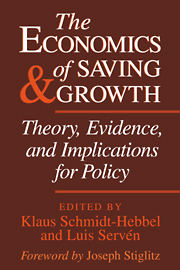Foreword Joseph Stiglitz
Published online by Cambridge University Press: 18 December 2009
Summary
Since the 1960s, world saving rates have followed a declining trend, accompanied by an increasing saving disparity across developing regions: saving rates have doubled in East Asia, stagnated in Latin America and the Caribbean, and collapsed in sub-Saharan Africa. Saving rates have also declined sharply in former socialist economies since the beginning of their transition toward a market economy in the early 1990s.
These regional saving disparities have been closely reflected in growth performance: higher-saving regions have also enjoyed faster income growth. High saving alone cannot guarantee the achievement of rapid and sustained growth and the reduction of poverty, but the international evidence does suggest that high saving inevitably accompanies that pursuit. Dissecting this empirical association between saving and growth into causal mechanisms is of utmost importance to both theorists and policy makers committed to achieving high growth and poverty reduction. There is a virtuous cycle in which high growth promotes high saving, and high saving in turn promotes fast growth.
The available evidence also suggests that high saving is associated with good macroeconomic performance and sustainable access to foreign lending. However, the recent turmoil in East Asia also reveals that while high levels of national saving contribute to domestic and external stability, they do not offer full insurance against the risks posed by fragile financial systems or unsustainable exchange rate policies. Therefore a better understanding of the interplay between financial and macroeconomic policies, on one hand, and saving, on the other, is another key priority from the policy perspective.
- Type
- Chapter
- Information
- The Economics of Saving and GrowthTheory, Evidence, and Implications for Policy, pp. ix - xPublisher: Cambridge University PressPrint publication year: 1999



